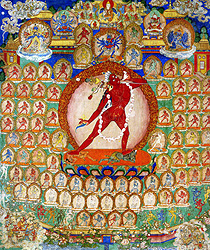|

 |
|
The
Sarvabuddha Dakini (Narkahajid)
Ink and colors on cotton; Late 18th Century
Museum of Fine Arts, Ulaan Baatar
The
Red, or Sarvabuddha Dakini is the female embodiment of Supreme
Knowledge and hte magic powers of all Buddhas.
|
Buddhism, one of the world’s oldest and most widespread religions,
derives from the Buddha, who was born a prince named Siddhartha
Gautama in what is now Nepal in 563 B.C.E. As a young man, Siddhartha
renounced his princely life and set out to find the cause of human
suffering. After years of searching, he attained enlightenment and
began to teach others. The doctrine he taught emphasized that suffering
can be transcended by adherence to a moral code and by the achievement
of wisdom through meditation. After Buddha’s death, his teachings
were spread by followers and an organized religion took form. With
the passage of time, a new branch of the religion emerged called
Mahayana. An important element in Mahayana belief is the worship
of bodhisattvas, who like the Buddha are spiritually advanced, but
choose to remain on earth to help others in their quest to attain
enlightenment.
A version of Mahayana Buddhism that emphasized the importance of
rites and ceremonies to help in this quest toward enlightenment
became popular in Tibet. This Esoteric Buddhism, or Lamaism (from
the Tibetan name for religious teachers, lamas, or superior ones),
derived much of its inspiration from Indian tantric practices
but also drew on the ancient shamanism and sorcery of Bon, a primitive
animistic religion of Tibet.
When the Mongol emperor Kubilai Khan (reigned 1260-94) chose Lamaism
as his state religion, his considerations were probably manifold.
While some historians claim that his motives were purely political,
others believe that the decisive factor may have been that the lamas
had a more potent arsenal of magic formulas at their disposal than
their adversaries, the shamans. Buddhism, with its all-inclusive,
systematic vision of the world and its well-administered hierarchical
structure had many points in its favor to make it more practical
and attractive in the eyes of conquerors than the unstructured shamanism
in which they were raised.
Moreover, the vast pantheon of Lamaism with its august Buddhas,
its peaceful gods, its charming goddesses, and its colorful and
gruesome Protectors of the Law had the capacity to absorb local
deities and to make their power and influence subordinate to the
Buddhist law. It is likely that the prime importance that Lamaism
accorded to the authority of the spiritual leader also appealed
very strongly to Mongolian sentiment.
Mongolian Buddhism was at this time was a religion imposed from
above by the court and was probably restricted to elite strata of
Mongol society. Indeed, the legacy of this first phase of Mongolian
Lamaism is seen more in China than in Mongolia. The Tibetan monk
‘Phagspa (1235-1280), who had originally come to the Mongol imperial
court not as a missionary but as a hostage to ensure the good behavior
of his unruly compatriots, had considerable success in conducting
his missionary activities in court circles. During the rule of the
Mongols, a number of important Lamaist monuments were built in China,
including the White Pagoda of Beijing and the Juyongguan Gate just
inside the Great Wall near Beijing. In Mongolia proper, on the other
hand, hardly anything has been preserved to remind us of early Buddhism.
With the breakup of the Mongolian empire and the return of many
Mongols after their expulsion from China in 1368, Lamaism virtually
disappeared in Mongolia, although it continued to flourish in China.
The second conversion of Mongolia to Buddhism was a more gradual
process and more far reaching. The key event was the meeting in
1576 between Altan Khan, leader of the Tümed Mongols, and Sonam
Gyatso, patriarch of the reformed Gelug order, or Yellow Hat Sect,
of Tibetan Buddhism. At this meeting Altan Kahn conferred the title
of third Dalai (Ocean, or Boundless) Lama on the patriarch and pronounced
his two predecessors to be the first and second in the lineage.
In turn, Sonam Gyatso pronounced Altan Khan to be the reincarnation
of Khubilai Khan, thus beginning a long and close relationship between
the Mongol Khans and the Tibetan theocracy.
The strength of this relationship was underlined in the mid-seventeenth
century when the Fifth Dalai Lama recognized Jebtsundamba Khutuktu
(Mongolian: Undur Gegen) Zanabazar as the reincarnation of the Tibetan
patriarch and historian Taranatha. Zanabazar was an enormously important
spiritual figure who helped unite Mongolia’s chiefs under Buddhism,
built monasteries, and preached the faith.
He was also a pioneer in such widely diverse fields as medicine,
literature, philosophy, art, and architecture. It was Zanabazar
who, in 1656, introduced the Maitreya festival into Mongolia.
Although the Tibetan church continued to dictate doctrinal orthodoxy,
such doctrinal differences between Tibetan and Mongolian Buddhism
that exist are more a matter of nuance than of dogmatic divergence.
Buddhist practices and iconography in Mongolia, nevertheless, exchanged
many elements with shamanism. Over time, Buddhist expressions and
ideas were inserted in the exorcist formulas with which the shaman
chased away evil spirits. For example, on house altars in the ger
(circular tent), the shamanistic onggon (ancestral figure)
were replaced by Buddhist images of Mahakala, the Protector of the
Law. Likewise, Buddhism was obliged to adopt many concepts and practices
of its adversaries. In Mongolia the Tsam festival, known throughout
the world of Tibetan Buddhism, would seem to have preserved much
more of its excorcistic aspects fundamental to shamanism than in
other regions.
So successful was this adaptation that Lamaism became a popular
religion. It is said that during the nineteenth century, forty-five
percent of the male population of Mongolia were lamas. During the
1930s, this remarkable flourishing of Buddhism came to an abrupt
and tragic end. More than 700 monasteries were razed, high-ranking
ecclesiastics were killed, and lamas of lower ranks were obliged
to return to secular life.
|